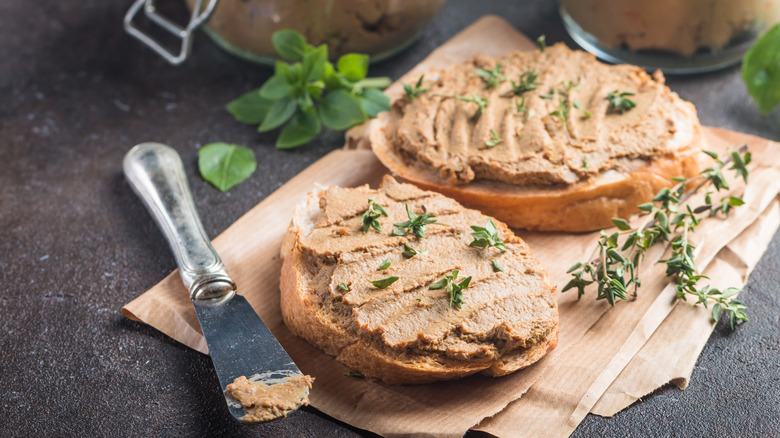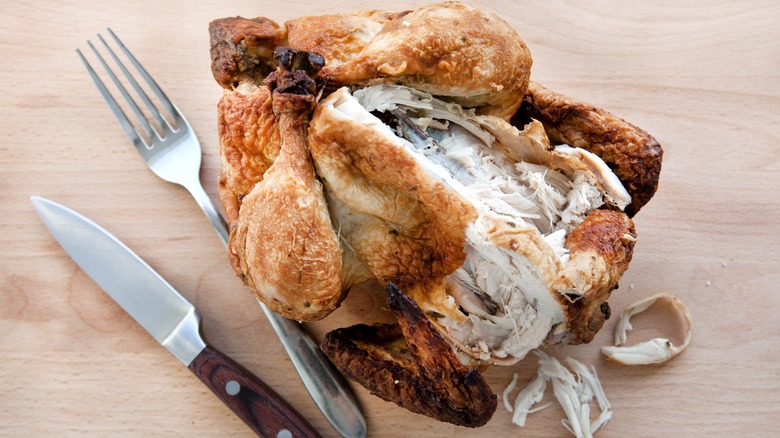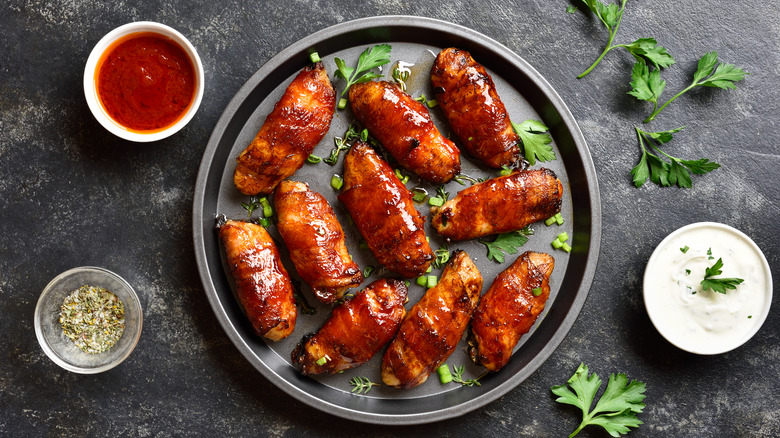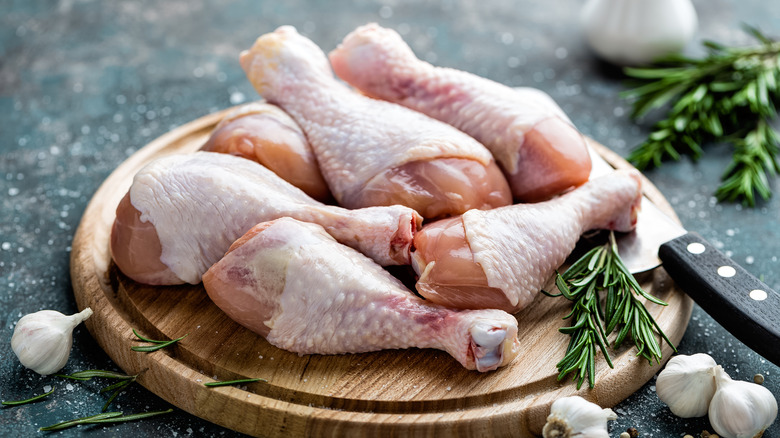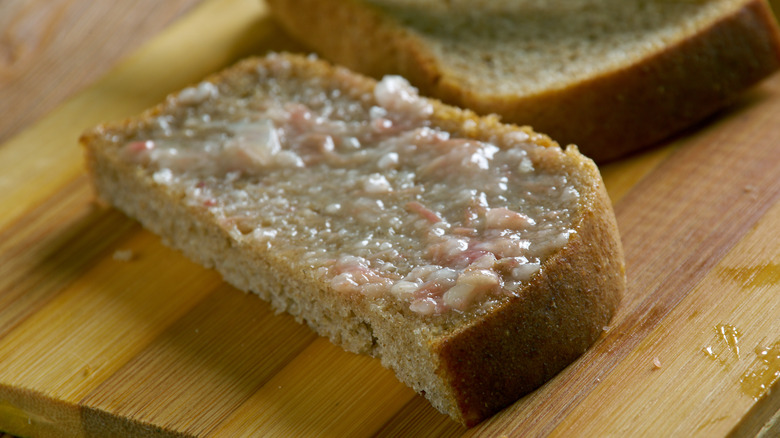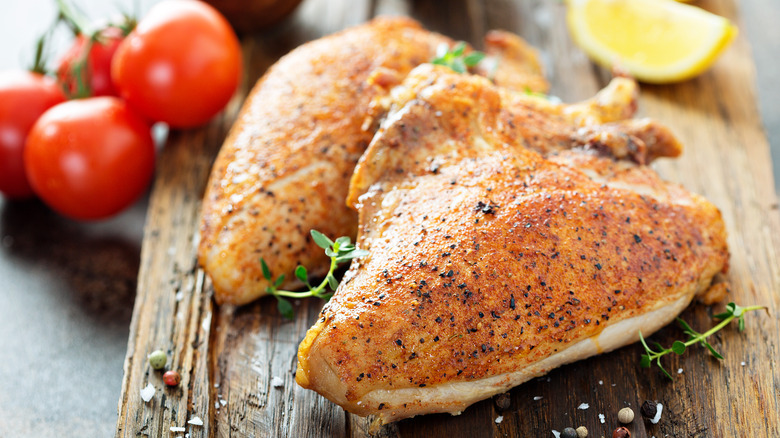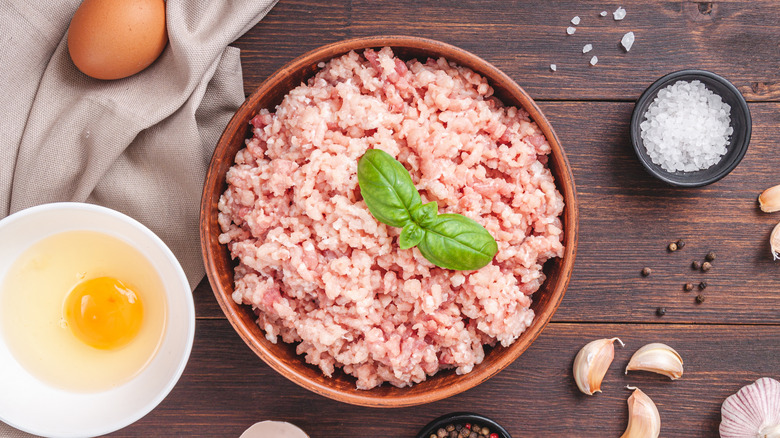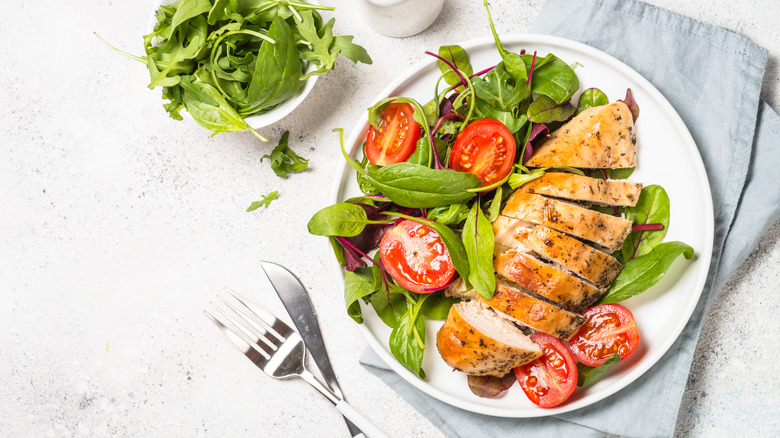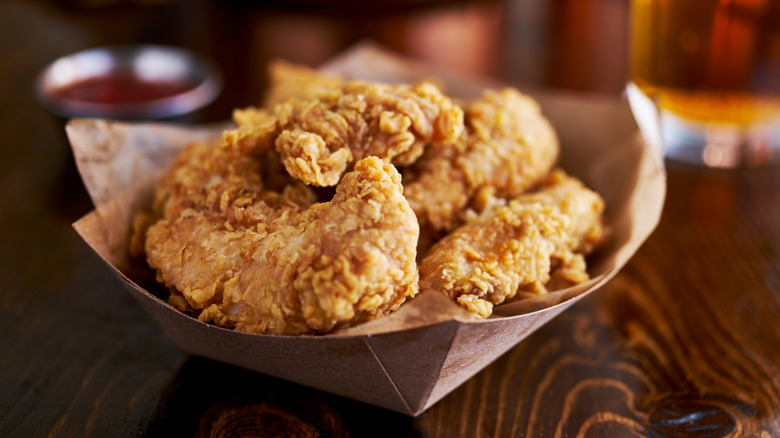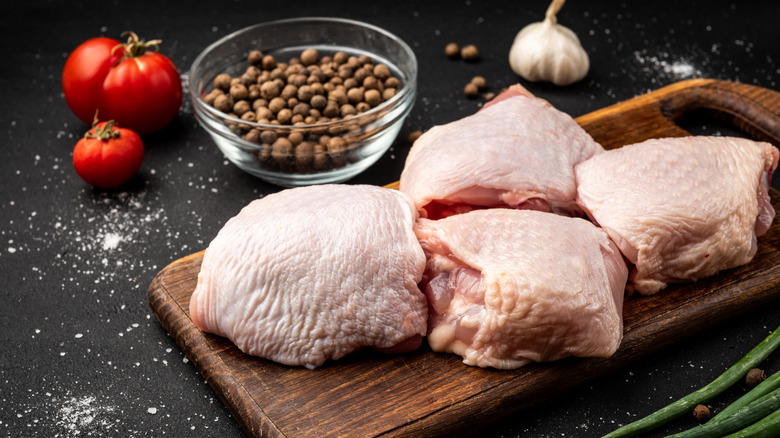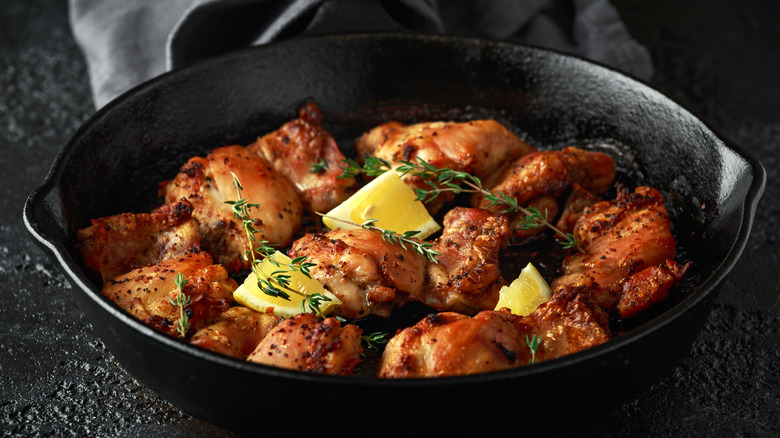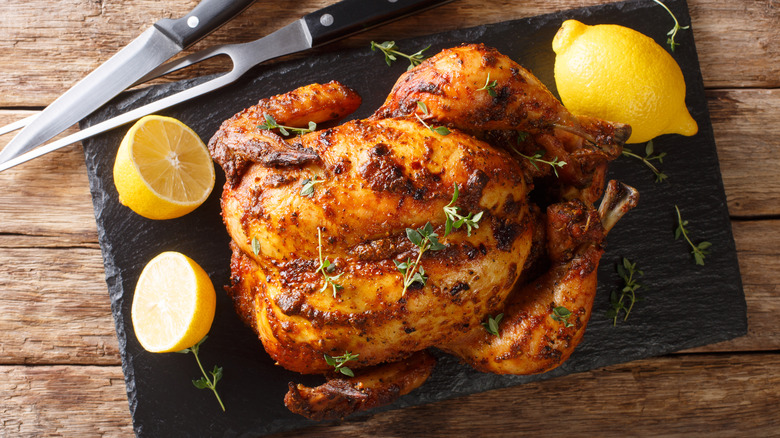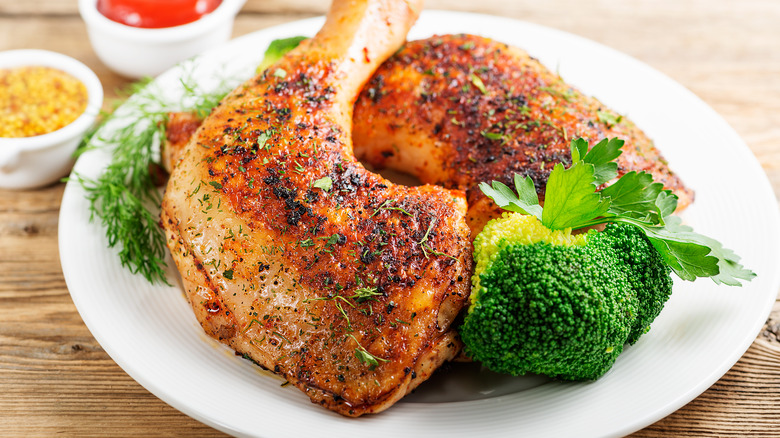Cuts And Parts Of Chicken Ranked Worst To Best
We may receive a commission on purchases made from links.
Chicken is one of the most common forms of protein found on dinner tables throughout the world. Most home cooks have at least one stellar chicken dish they can rely on when they need an impressive dinner in a pinch. According to global trading company KIT International, chicken is the most consumed protein in the world, far surpassing pork and beef with global consumption of around 98.5 million tons. Maybe it's because chicken is known for being a healthy protein source, providing our bodies with low-calorie, low-fat fuel. According to the National Chicken Council, beyond protein, chicken also contains vitamin B12 and choline, essential for healthy brain function. It also boasts tryptophan, an amino acid that raises serotonin in the brain, and a range of other under-consumed vitamins and minerals.
But the cut of chicken that you buy and cook plays a large role in how many of these benefits you reap — not to mention how tasty your final dish is. Varying fat content, skin-on versus skinless, and bone-in versus boneless are all factors that influence the dining experience. Plus, certain cuts or parts of chicken just won't work for certain recipes.
To help you decide the best cut or part of chicken for your next meal, we're ranking them from worst to best and giving you the skivvy on when to use even the lowest-ranked pieces on our list.
14. Chicken livers
There's a lot to be said for chicken livers. They're extremely healthy, for one. In fact, they're so healthy that, in a Dallas News article, a dietician called them "one of the best foods you can eat," pointing to liver's high iron, folate, choline, and biotin content. But despite this, chicken livers come with a certain stigma. Sometimes called "offal," another word for organ meat (via US Wellness Meats), chicken livers are small and typically metallic in taste, thanks to all that iron. They're usually fried or served as a smooth pate that can be spread on other foods.
The taste of chicken liver is an acquired one, to be sure, but many diners don't make the point to actually try to acquire it, simply because the idea of eating a liver makes them squeamish. It's that stigma, as well as the potentially finicky cleaning and cooking process needed for them to shine that lands chicken liver at the bottom of our list.
13. Chicken backs
The chicken back isn't as well known as the chicken liver, so it hasn't really had the opportunity to build up any sort of poor reputation, even though it is just as unusual as a chicken liver. A chicken back is, according to US Wellness Meats, what's leftover after a butcher (or you, if you're breaking down a whole chicken at home) removes the wings, breasts, and legs. It's basically the bony leftovers that remain behind after a family has picked a whole chicken clean. You probably wouldn't buy this cut on its own, because it doesn't really have a lot of value — except in one instance.
As it turns out, chicken backs are incredibly good for making stock. While they're low on meat, they're high on fat and bone marrow. Settle them into a low-simmering pot of water with a few seasonings and veggies and you'll have an amazing chicken stock in the span of a few hours. However, while the chicken back shines when it comes to stock-making, that's all it really does well, giving it a low spot on our list.
12. Chicken wing drumettes
Chicken wings rank low on our list overall for several reasons. Like a chicken back, a chicken wing has one primary purpose: to be fried or smothered in Buffalo sauce, like then to be eaten during sporting events alongside a cold beer. The lack of versatility counts against it, though we're sure that wings have plenty of devoted fans. However, when you order a basket of wings, you usually get two types: drumettes and flats. And, if we compare the two, the truth is that drumettes just can't stand up to flats.
Why? Well, as a Syracuse.com article points out, while you get more meat per wing when you chow down on a drumette, with its little chicken leg-like appearance and singular bone, the skin-to-meat ratio is lower than what you get with a flat. That means there's not as much overall flavor and, in essence, there's more room for error. Compared to other cuts of chicken, chicken wings are very easy to overcook. One wrong move and you have a horrifically dry piece of meat on a very tiny bone, with less fatty skin to lend a hand to your dried-out drumette.
11. Chicken wing flats
As pointed out by Syracuse.com, the chicken wing flat is superior to the chicken wing drumette. The higher skin-to-meat ratio makes for a tastier, fattier, moister wing, even if you don't get as much meat overall. Plus, because you don't have that hard end of the drumette bone to work your way around, it's usually easier to get all of the meat actually off of the flat. Even better, flats have less cartilage than drumettes.
Thrillist took a tally of wing-lovers in an effort to finally prove once and for all if the flat or the drumette is the more preferred version of the chicken wing. The result? "At the end of this highly scientific, definitely conclusive study, flats win by the skin of their, um, wings," Thrillist reported. "Drums are great and all, but by a narrow margin flats edged out their fatter cousin thanks largely in part to their exemplary crispy skin and ability to hold more sauce."
10. Drumsticks
Despite some confusion (like that of this Quora user questioning why they always get a drumstick when they order wings), a drumstick is not the same thing as a drumette. They look similar, sure, but the drumette is definitely part of the chicken wing, even if it doesn't look very wing-like when it arrives in front of you covered in sauce.
The drumstick is very different, being part of the chicken's leg. Larger than a drumette and with more meat, drumsticks are very affordable and easier to cook than wings, according to Jamie Oliver. This is largely why the cut ranks higher than wings on our list. The one thing holding it back from ranking even higher? It's not very versatile. After all, no one's going to bother cooking a drumstick for a chicken soup. If we're being honest, drumsticks are purely cooked with the idea that you'll be eating that sucker with your hands. Instead, a chicken drumstick is usually best suited for a limited range of settings and cooking methods, like frying, grilling, or barbecuing.
9. Schmaltz
As we edge toward the middle of our list, we come across a specialty product that you may not have encountered before. Per MasterClass, schmaltz is most popular in Jewish cuisine and can often be found at your local kosher butcher's shop. Basically rendered chicken fat, it has a strong flavor that's beloved by many. You can use it for frying vegetables or making soup and it's a popular addition to latkes and matzo ball soup. Some devotees even spread it on bread and enjoy it more directly that way.
If you're already accustomed to making your own chicken stock at home, you can easily make your own schmaltz with just a few extra steps. According to Splendid Table, "If you like to make chicken soup, save all the skin and fat before you put the bird in the pot. If you roast a chicken regularly, you can pull loose fat from it and trim unused skin, saving it in the freezer until you have enough to render for schmaltz." From there, it's just a matter of a little chopping, rendering, and straining to create this tasty — but admittedly high-fat — addition to your kitchen arsenal.
8. Split chicken breasts
Split chicken breasts definitely aren't the most popular cuts of chicken at the supermarket. In fact, if you're shopping at a big-box retailer, you might not even be able to find split chicken breasts. If you're really dedicated, you may have to pay a visit to your local butcher instead. So why would you even bother going through the trouble? As Cook's Illustrated points out, "buying bone-in chicken breasts, and then removing the bones at home, is often the only option when your recipe requires boneless chicken breasts with skin intact." And so, a split chicken breast ends up on your grocery list.
But how often are you really going to need boneless chicken breasts with the skin still on them? Cook's Illustrated includes a few recipes to prove their point, but, at the end of the day, you're not normally going to need this cut of chicken, especially if you're cooking your average chicken dinner. It may not be worth the trouble for most home cooks.
7. Ground chicken
Right in the middle of the pack, ground chicken is a lower-fat alternative for use in recipes where you might normally use beef or pork. Per Taste.com.au, most ground chicken is made from either dark or white meat (or a mix), with or without skin included. The lighter the chicken, the less fat in the final ground product. The darker the chicken, the more flavor. Grinding your own chicken at home does allow you to adjust the dark meat to white meat ratio, but grinding your own meat isn't exactly something every home cook wants to do.
So why the reason for ground chicken's middle-of-the-pack ranking? Ground chicken comes with a lot of pros, after all. It's healthier than red meat and so, so versatile. Make burgers, a meatloaf, meatballs, sauces, whatever your heart desires. But, on the con side, ground chicken also isn't as flavorful as your other ground meats, so if you're expecting your meaty marinara sauce to taste exactly the same when you switch out your Italian ground sausage for ground chicken, you'll be sorely disappointed. Switching from ground red meat to ground chicken also comes with a bit of a learning curve (via Chicken.ca). If you go that far, you'll need more seasoning and more added moisture, and you'll have to cook your meat at a lower temperature.
6. Boneless chicken breasts
Did you expect boneless chicken breasts to rank as our top favorite cut of chicken? It wouldn't be that unexpected. After all, boneless chicken breasts are one of the most popular cuts of chicken out there by far, thanks in large part to their versatility. You can pan-fry them, bake them, grill them, and shred them for use in casseroles or soups. They're low-fat, too, making them one of the healthier cuts of chicken. However, despite all of the good that boneless chicken breasts offer, they also come with some downsides, which is why they didn't rank higher on our list.
It's no secret that boneless chicken breasts are bland. They're not exactly something you can just cook on their own and then expect a flavorful meal. You'll have to add some seasonings, some fat, some extra flavor, and some cooking skill to really make these taste great. Additionally, as Kitchn notes, boneless, skinless chicken breasts are the most expensive cut of chicken on average. As of a few years ago, the average national price of skinless, boneless chicken breasts per pound was $3.33. Compared to chicken leg quarters, which were an average of $0.89 per pound, and you can see why we hesitate to rank boneless chicken breasts any higher.
5. Chicken tenders
Chicken tenders aren't just for kids anymore. Sure, you may know them best via the standard chicken tender platter available at every sit-down restaurant chain in America, but chicken tenders offer a wealth of potentially surprising benefits, which is why they rank higher than chicken breasts on our list. In addition to being cheaper per pound than chicken breasts, chicken tenders pack a lot of the health and versatility of a chicken breast into a smaller size. Because of this smaller size, chicken tenders require a shorter cooking time and not as much prep work in some instances. For example, you're never going to feel the need to break out the meat mallet to tenderize some chicken tenders, right?
Chicken tenders are, though, technically part of the breast. The white meat is, according to US Wellness Meats, the part of the chicken breast that isn't directly attached to the ribs. Because of this location, the tenders are actually more, well, tender without any added fat or calories compared to a piece of dark meat.
4. Bone-in chicken thighs
If your primary concern is flavor, as opposed to counting calories and paying strict attention to cholesterol levels, then you can't go wrong with bone-in chicken thighs. Just as versatile as a chicken breast, but with more flavor, chicken thighs can be baked, grilled, roasted, popped into the slow cooker, and much, much more. When cooked to perfection (which really isn't that difficult), the meat slides right off the bone. It's especially well-suited for use in casseroles, soups, tacos, sauces, dips, and other recipes where shredded chicken is needed.
As Jamie Oliver eloquently puts it, "[Chicken] thighs are little parcels of tender, juicy meat from the top of the bird's leg. You can buy them bone in, or bone out, and with the skin on or off. The meat is darker and firmer than the white breast meat and needs slightly longer to cook." Because of this, bone-in chicken thighs rank high on our list of best cuts and pieces of chicken.
3. Boneless, skinless chicken thighs
If you don't want to fiddle with removing the bone (or eating around it) that's part of the bone-in chicken thighs experience, while you also want a little bit of extra healthfulness, you can go with boneless, skinless chicken thighs. WIth this cut of chicken, you get the versatility, ease of cooking, and extra flavor of chicken thighs, but obviously without the bone or skin. You can use boneless, skinless chicken thighs any way that you might use chicken breasts or chicken tenders, though you benefit from the extra moisture and flavor found in the cut, as well as a typically cheaper price.
As for bone-in versus boneless cooking time, it all depends on how you plan on cooking your thighs, according to OurEverydayLife. If you're grilling or baking, boneless is faster. If you're simmering the chicken in a stock or soup, the cooking time stays the same. Regardless of how you cook your boneless or bone-in chicken thighs, though, you'll always know the cut is finished when the internal temperature of the chicken at its thickest part is at a minimum 165 degrees Fahrenheit.
2. Whole chicken
Cooking a whole chicken is an art. Roasted, golden-brown, simmering in its own juices, and served up alongside some simple veggie side dishes, what else could make a more comforting meal? Not to mention, absolutely nailing a whole roast chicken is an impressive feat, making the dish an ideal option to serve for a "fancier" meal where you aim to impress.
Plus, when you cook an entire chicken, everyone who's eating can pick their favorite cut — it's all up for grabs. So, if you have a family of mixed preferences, no one is disappointed. Whether someone wants a wing, a drumstick, some dark meat, a bit of white meat, they get it all. Then, when the bird is picked clean, you can use that chicken back and the other bones to make a delicious homemade stock. And if you needed even more reasons to opt for a whole chicken versus buying individual cuts, just note that a whole chicken boasts the average second-cheapest cost per pound according to Kitchn, at $0.94 per pound in 2017.
The only thing that keeps this option from ranking at the top spot on our list is the fact that cooking a whole chicken is admittedly more work than just popping a casserole dish of chicken thighs or chicken breasts into the oven. Still, if you can put forth the extra effort, it should be well worth your time.
1. Chicken leg quarters
In our top spot for best cut or part of the chicken? Chicken leg quarters. This king of chicken cuts offers the cheapest cost per pound according to Kitchn's data on nationwide prices. The dark meat is flavorful and moist, and the extra fat content makes it difficult to overcook. Since you're purchasing an entire leg quarter, which includes both the chicken thigh and the chicken drumstick, you get two cuts of chicken in one go. That's potentially handy, just in case you have folks in the family who prefer drumsticks over thighs or vice versa. You can even choose to separate the thighs and drumsticks and then cook them separately as needed. Still, when kept as one piece, the leg quarters are versatile enough to be used in a range of ways, from grilling to roasting to baking to simmering in a sauce.
To sum up, if you're looking for a cut of chicken that's going to give you the best flavor and the best versatility for the least amount of money and the least amount of work, you've found it. Look no further than your grocery store's chicken leg quarters.

